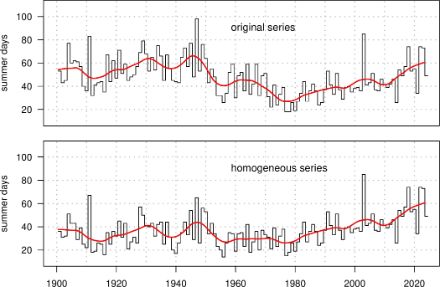Almost all available series of climatic measurements have been established under measuring conditions that have changed over time. The most common causes of such changes include the relocation of stations, the use of new measuring tools or changes in the surroundings. This problem is illustrated in more detail in connection with the territorial shift of the temperature measurement associated with a difference in altitude. As the temperature on average decreases with increasing altitude, such a shift results in an abrupt change in the series of measurements, which does not in any way correspond to the actual and natural development.
Adaptation to current measuring conditions
The homogenisation removes these artificial changes in the series of measurements. In so doing, historical measured values are adapted to current measuring conditions and non-climatic influences are hence removed from the series of measurements. The weather service MeteoSchweiz has worked many years to develop a proven method for this task and is applying it systematically to data series of its ground-based stations.
No climatic statements without homogenisation
Homogenised climatic series reveal an unaltered picture of the past climatic development. Such climatic series are the only option allowing us to make accurate statements about the climatic development, because the discrepancies between inhomogeneous original and homogeneous climatic series can be considerable.
